
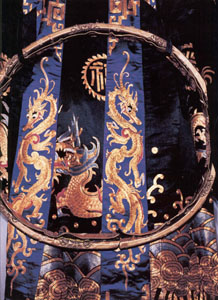
A Close-up of Costume Embroidery and Designs. Click to go to Costume Page.
Music
About Cantonese Opera
This page co-authored by Stacey Fong and Erick Lee.
Cantonese
Opera is a traditional
Chinese art form that involves music, singing, martial arts, acrobatics, and
acting. Cantonese Opera plays tell stories about Chinese history,
traditions, culture, and philosophies.
Cantonese
Opera Costumes


A Close-up of Costume Embroidery and
Designs. Click to go to Costume
Page.
Music
Cantonese Opera music
consists of innumerable melodies and tunes. Unlike European opera where
the composer of the music is praised, in Cantonese opera the music isn’t the
most important part - the lyrics are. In
Cantonese opera the writers put words into this pool of melodies and tunes.
One song may contain many melodies, and it is up to the singer to add his
or her own personal variation and style to the melody when they sing it.
The singing must be combined with music, of course. Traditional Chinese
instruments such as the er wu (yee wu), butterfly harp, pay-paa, flute, and
percussion, to say the least, make up the Cantonese Opera orchestra. The
percussion alone consists of many different drums and cymbals. The
percussion is responsible for the overall rhythm and pace of the music, while
the er wu leads the orchestra. Now,
Cantonese opera has incorporated many western instruments such as the cello,
saxophone, and even the violin which is often used in place of the er wu.
Types of Plays
There are two types of Cantonese Opera plays.
One is called "Mun," and the other is called, "Mo."
Mo means martial arts. Characters in Mo
plays are usually generals or warriors. Mo plays are action-packed
and intricately choreographed, often using weapons. The costumes for Mo
plays are very complicated (and heavy).
Mun means intellectual, polite, cultured.
These are the plays whose characters are either scholars, royalty. Mun plays
tend to be dramatic and the movements are soft and slow. Instead of using
weapons, performers show of their abilities in water sleeves work (see terms
below). This type of play focuses more on facial expression, tone of
voice, and meaning behind the movements.
While actors are singing and moving around on stage, they also have to
act! Cantonese opera acting is not the same as acting in movies or on TV.
Many emotions have certain facial expressions and body gestures that go along
with it. Performers also have to be careful not to ruin their makeup or
hair with histrionic expressions.
Makeup
Cantonese Opera makeup is very unique and
difficult to master. For the most common type of makeup, the white and red
face, the process is as follows. First,
a white or off-white base foundation is applied to the entire face, including
the neck and ears. Then, red rouge is spread across the eye area, blending
down to the cheeks and stopping just at the bridge of the nose.
Traditionally, the eyes and eyebrows are drawn following the natural shape.
Nowadays, the eyebrows must be drawn at a sharp, upward angle, and the
eyes are also drawn slanting upwards, to make them appear long. The actor
gives the eyes and eyebrows a lift using a flat black ribbon and pulling the
skin tightly upward and tying it tightly behind the head.
Some actors, now, prefer to use cosmetic tape to pull their eyes into a
slant, to lessen the discomfort, and it does make eyelining easier.
Lipstick is bright red. The
makeup helps enhance the actor’s facial features and many times tells the
audience a lot about the characters personality. For instance, if an actor plays a comical role, he will
usually paint a large white circular shape in the center of his face.
This tells the audience that he is a comical character.
If the character in an opera is ill, the actor playing that role paints a
thin red line in between the eyebrows upward, symbolizing sickness.
For male generals or male characters with a lot of aggression, the actor
paints a “ying hong jee” in
between his eyebrows. This is an
arrow shape that is painted and blended starting from between the eyebrows and
fading into the forehead. This
symbolizes a lot of frustration in the character.
|
|
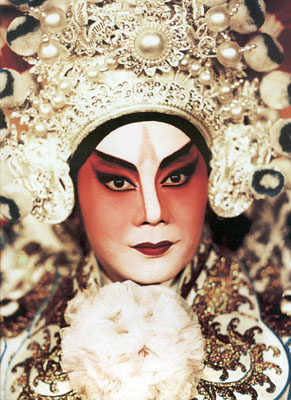 Actor Ding Faan as a male general, with ying hong jee on his forehead. From Chinese Opera. See reference page for book details. |
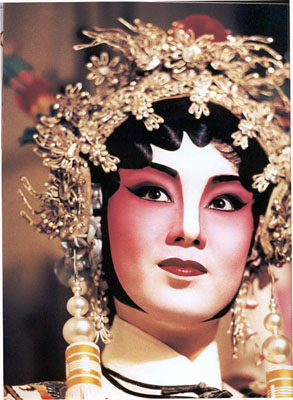 Closeup of female general. From Chinese Opera. See reference page for book details. |
There is also another type of face painting which
is always associated with Chinese opera. This
type is called “hoy meen” which
literally translates to open face. The
characters that wear this type of makeup are tall, broad male characters, such
as the three sworn brothers, in the famous story the
Romance of the Three Kingdoms, Guan Yu, Jueng Fey, and Lao Bey.
This type of makeup is truly an art of its own.
The actor applies many different colors of oil-base and water-base makeup
to create different faces of characters. Each open face character in opera has their own different
makeup. These consist of many
symbols, intricate details, and blending. The
colors used are just as important as the designs because each color also
symbolizes something different.
Pictured: Open Face. From Peking opera. See reference page for book details. |
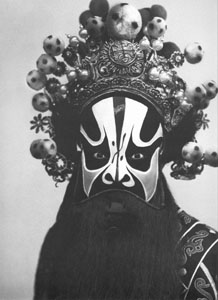 Open Face with Beard and helmet (dai ngak ji) From Chinese Opera. See reference page for book details. |
Hair
A performer’s hairstyle tells a lot about their
character’s age, status, and abilities.
Men will put on a hat, the design of which depends on their
character. Scholars or government officials have hats with two flaps on
the sides. Soldiers have very simple hats, while generals have large
helmets with pheasant feathers (see terms below). Kings wear crowns.
Pictures of hats can be viewed on the Costumes
Page. Besides hats and helmets, male characters also have hair “styles.”
For a general or warrior that has lost a battle and therefore lost his
helmet, a ponytail-like hairstyle is worn on the top of the head.
The character may swing the long hair in circles showing frustration or
grief (see terms below). Another
type of hairpiece that male roles can wear is a type of wig that has a bun on
the top of the head and hair flowing down the back.
This can be worn by numerous types of characters.
For older characters of opera, the beard is also a very important part of
the role. There are many types of
beards consisting of long or short, and black, white, grey, or even red!
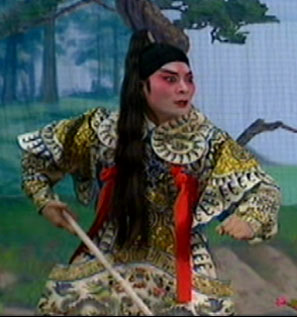 Actor Ngou Hoi Ming demonstrates the pony-tail hairstyle. From the opera Gate of the White Dragon. |
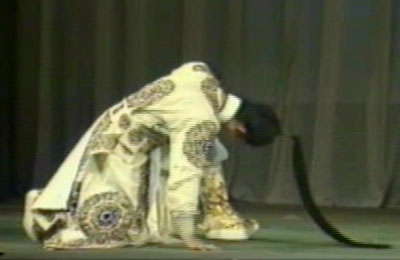 Actor Ding Faan flings his ponytail. From the opera Kneel Thrice, Bow Nine Times (Fan Lay Faa). |
 Character with white beard. From Chinese Opera. See reference page for book details. |
Women have to put on "peen jee," which are like
bangs. After the peen jee comes the larger hairpiece, which is usually a
ponytail that extends down past the waist. Then, the women adorn their
heads with jewelry, flowers, and other hairpieces. The hairstyle will tell
a lot about the woman's status. Women in mo plays almost always
wear helmets with peacock feathers. In Mun plays, the hairstyles
are more diverse. A maid or a young girl usually has her hair done in
buns, with little jewelry. A young, unmarried woman will have her hair
down (in a ponytail), with part of it swept up to one side, and jewelry and
flowers (more if she is rich). A married woman has two hairstyles: one is
called dai tow (literally, big head), where the woman has two very long
strands in the front, and the rest bound up and covered with jewels. The
other style is similar to an unmarried woman's, except the ponytail in the back
is tied up at the nape of the neck. Fairies or royalty usually have their
hair left down (in a ponytail), with a very high crown or tiara set in the
middle. If a queen or princess is at a formal party, they will wear what
is called a kwai, which is like a helmet adorned with jewels.
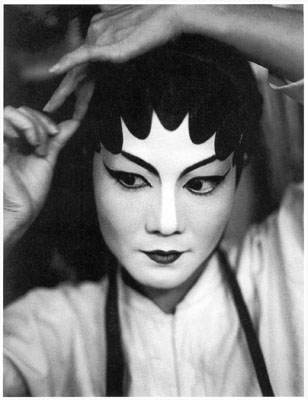 Woman applying Peen Jee. From Chinese Opera. See reference page for book details. |
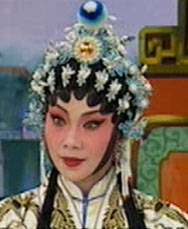 Actress Chung Wai with dai tow hairstyle. |
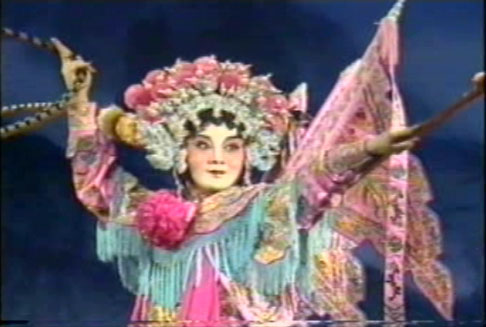 Actress Chen Wun Hung with female general's helmet. From the opera Kneel Thrice, Bow Nine Times (Fan Lay Faa). |
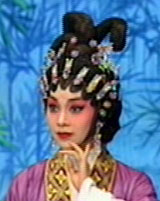 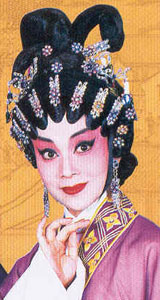 Actress Lee Sok Kun with an unmarried girl's hairstyle. From the opera Teen Ngai Fong Cho Fung Chun Hak. |
Cantonese
Opera's Frequently Used Terms
|
Pheasant
feathers/Antennae |
Worn
by both men and women in Mo plays. These are very long
pheasant feathers on the performer's helmet that...well...look like
antennae! The performer uses these feathers to express their
feelings or to display their skill. |
|
Water
Sleeves |
Usually
worn by both men and women, in Mun plays. These are very long
pieces of white fabric connected to the sleeves that, when handled
correctly, are supposed to flow as softly and smoothly as water.
The movements performed by the actor, or actress, with the water
sleeves have a symbolic meaning. |
|
Hand
Movements |
The
shape and position of an actor's hands and fingers will interpret the song
or the scene being performed. Generally, women must hold their hands
in a "lotus flower" position, which is considered softer and
more feminine than straightening all their fingers. |
|
Round
Table/Walking |
Cantonese
opera has very specific movements, and one of the most basic but difficult
is the walking (speed walking), affectionately called the round table.
Women have to take very, very small steps, while their upper bodies float
as if disconnected from their legs. Men can take larger steps but
their upper bodies have to also remain detached from their lower bodies.
This is a graceful movement and symbolizes traveling a long
distance. |
|
Go
Hur |
Opera
shoes worn by men. It consists of a black boot with a thick and high
white sole. This makes round table for men very difficult. The
higher the shoes, the harder the round table and all other movements are! |
|
Gwou
Wai |
A
move in which two performers cross over to opposite sides of the stage. |
|
Tuir
Mok |
A
move in which the two performers walk in a circle facing each other and
return to their original positions |
|
Lai
saan & Wun Sou |
This
is the most basic movement that combines the hands and the arms.
This movement is used in many other more complex moves and is one
of the moves that is taught first to beginners is opera. |
|
Jurt
Bo/Choot Bo |
Used
in Mo or Mun plays by men
and women, this technique is often incorporated into the round table.
It looks like skipping, but the body should glide, not jump. |
|
Siu
Tiu |
Translated
as “small jump,” this movement is generally used in Mo plays. It is
somewhat like a stomp with one foot before starting a round table.
This movement is done smoothly. |
|
Fay
Tuir |
In
regular martial arts terms, it would be called an inside crescent kick. |
|
Hair-flinging/ |
This
movement can be done by both male and female roles, in Mun or Mo plays.
This is where they swing their ponytails in a circle over and over
again. This symbolizes
frustration or grief, such as when a loved one dies in a dramatic way. |
|
Chestbuckle/
Flower |
This
is a spherical flower made from a long length of fabric that is folded a
certain way, tied very tightly, and then shaped into a sphere, similar to
a NordstromÔ
gift box bow. They are worn
by male and female Mo roles as a
decoration on the chest, and also a red flower is worn by a male when
getting married. |
|
Horsewhip |
This
is a prop that people use on stage to symbolize a horse or riding on a
horse. It is a thin piece of
rattan that is about 3 ft. long and is bound with colored silk and
tassels. The actor or actress
swings the whip and starts a round table, which symbolizes riding a
galloping horse. |
|
Sifu |
Literally,
“Master,” this term is used for professional actors (who have been
trained in schools in China). It
is also what opera students call their opera teacher/coach. |
[Home]
[About
Cantonese Opera] [News & Events] [ABC
Corner] [NBC
Corner] [CBS
Corner]
[Editorials] [Spotlight on...] [About
this site]
©
2002-2003 Bay Area Cantonese Opera. All rights reserved.